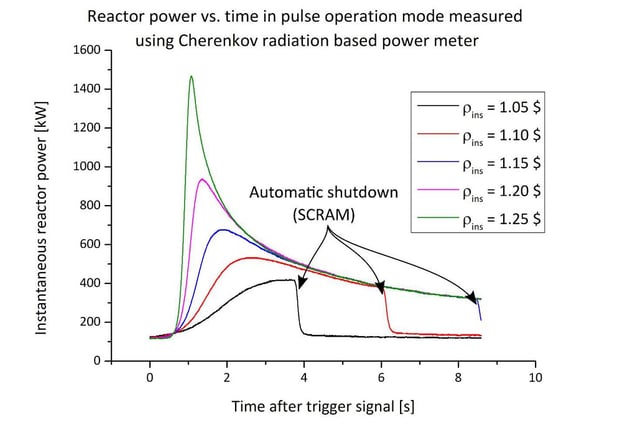Testing a new exercise at the JSI TRIGA reactor - Cherenkov radiation-based power meter
-
Posted by
 Red Pitaya Team
, May 27, 2021
Red Pitaya Team
, May 27, 2021

A Cherenkov radiation-based power meter was successfully set up at the JSI TRIGA reactor in Ljubljana in the framework of a Master thesis and demonstrated for the first time on 13th April 2021 with the collaboration of a group of 2nd Bologna degree Nuclear Engineering students of the Faculty of Mathematics and Physics of the University of Ljubljana.
The experiment consisted of measurements of the intensity of Cherenkov radiation emanating from the reactor core using a silicon photomultiplier (SiPM) located in a light-tight channel and a RedPitaya board, operated by a Python script on a laptop computer. Due to the Covid-19 pandemic, the students participated in the exercise remotely via Zoom. Their task was to evaluate the detector response linearity and perform a response calibration by measuring the signal at different constant reactor power levels, ranging from low power (several kW) to full power (250 kW). Subsequently, the students used the detector and the obtained calibration to determine the peak power and released energy in pulse operation mode, the peak power reaching well over 1 MW.
The demonstration was carried out successfully – the detector signal in both steady-state and pulse operation modes was well measurable. The experience gained, and the feedback received on the exercise will greatly assist in the implementation of this exercise and integration in the ENEEP platform offerings (Source: https://bit.ly/3fuVTZu).

We are happy to present the testimony from Vladimir Radulović a researcher at the Reactor Physics Department (F8) at Jožef Stefan Institute.
"At the Jožef Stefan Institute TRIGA research reactor, we employed a RedPitaya board to perform Cherenkov light intensity measurements in reactor pulse operation mode in the framework of a bilateral research project in collaboration with the French Atomic and Alternative Energy Commission (CEA). The RedPitaya board was an ideal tool for this task, thanks to its excellent performance and flexibility. We are planning to use it in further research work as well as in the context of nuclear education activities in collaboration with the Faculty of Mathematics and Physics - University of Ljubljana, and in the framework of the ENEEP project, funded by the European Commission, offering hands-on exercises to students and professionals at the EU level."
About the Red Pitaya Team
The Red Pitaya editorial team consists of engineers, researchers, and product experts who develop and test cutting-edge open-source test & measurement solutions.
Our mission is to make advanced instrumentation accessible to everyone — from students and educators to leading research labs worldwide.



